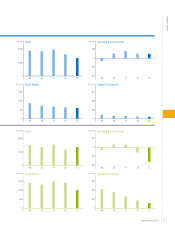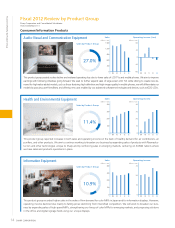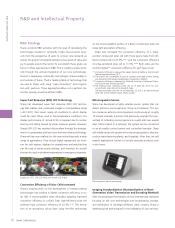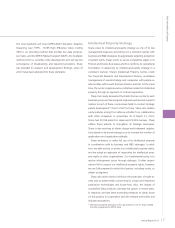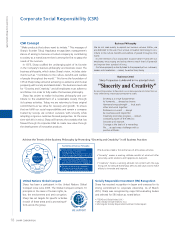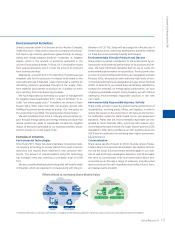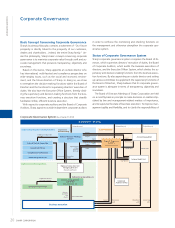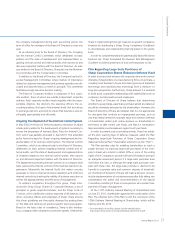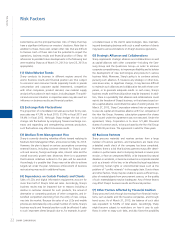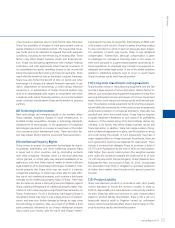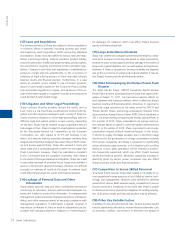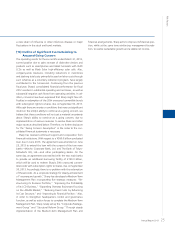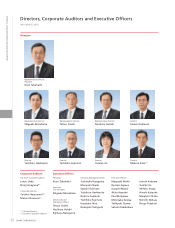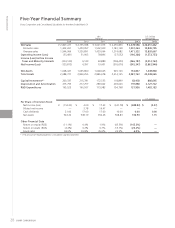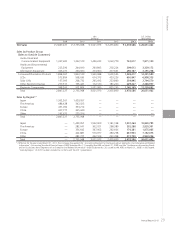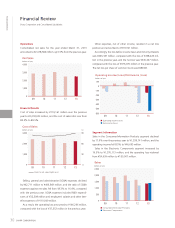Sharp 2013 Annual Report Download - page 22
Download and view the complete annual report
Please find page 22 of the 2013 Sharp annual report below. You can navigate through the pages in the report by either clicking on the pages listed below, or by using the keyword search tool below to find specific information within the annual report.
20 SHARP CORPORATION
Corporate Governance
Corporate Governance
Basic Concept Concerning Corporate Governance
Sharp’s business philosophy contains a statement of “Our future
prosperity is directly linked to the prosperity of our customers,
dealers and shareholders ...indeed, the entire Sharp family.” Un-
der this philosophy, Sharp’s basic concept concerning corporate
governance is to maximize corporate value through swift and ac-
curate management that preserves transparency, objectivity and
soundness.
Based on this stance, Sharp appoints an outside director who
has international, multi-faceted and compliance perspectives on
wide-ranging issues, such as the social and economic environ-
ment, and the future direction of Sharp. In doing so, we strive
to strengthen the decision-making functions within the Board of
Directors and the functions for supervising directors’ execution of
duties. We also have the Executive Officer System, thereby divid-
ing the supervisory and decision-making functions from the busi-
ness execution functions, and creating a structure that steadily
facilitates nimble, efficient business execution.
With respect to corporate auditors and the Board of Corporate
Auditors, Sharp appoints outside independent corporate auditors
in order to reinforce the monitoring and checking functions on
the management and otherwise strengthen the corporate gov-
ernance system.
Status of Corporate Governance System
Sharp’s corporate governance system comprises the Board of Di-
rectors, which supervises directors’ execution of duties, the Board
of Corporate Auditors, which audits the business executions of
directors, and the Executive Officer System, which divides the su-
pervisory and decision-making functions from the business execu-
tion functions. By also appointing an outside director and setting
up various committees to supplement the supervisory functions of
the Board of Directors, Sharp believes that its corporate govern-
ance system is adequate in terms of transparency, objectivity and
soundness.
The Board of Directors Meetings of Sharp Corporation are held
on a monthly basis in principle to make decisions on matters stip-
ulated by law and management-related matters of importance,
and to supervise the state of business execution. To improve man-
agement agility and flexibility, and to clarify the responsibilities of
Shareholders’ Meeting
Business execution
Representative directors/
managing directors
(Executive officers)
Corporate
Auditors Office
Supervisory/decision-making functions
Business execution functions
Audit functions
Corporate Governance System
( A s of June 27, 2013)
Election/dismissal Election/dismissal Election/dismissal
Supplement supervisory
functions
Supervision/
decision making
Supervision
Supplement business
execution functions
Business
execution
and
checks Discussion/report
Report Operational
audit
Operational
audit
Accounting
audit
Appointment/
removal
(Election/
dismissal)
Resolution/
report
Report
Monitoring
Coordination Coordination
Coordination
Coordination
Report
Report
Audit
Audit
Report
Deliberation on key policies, etc.
Report Accounting auditors
Internal Audit Unit
Directors
Board of Directors Meeting
Corporate auditors
Board of Corporate
Auditors
Internal Control Committee
Special Committee
Compensation Committee
Consultative Committee
Nominating Committee
Executive Management
Committee
Executive officers, etc.





